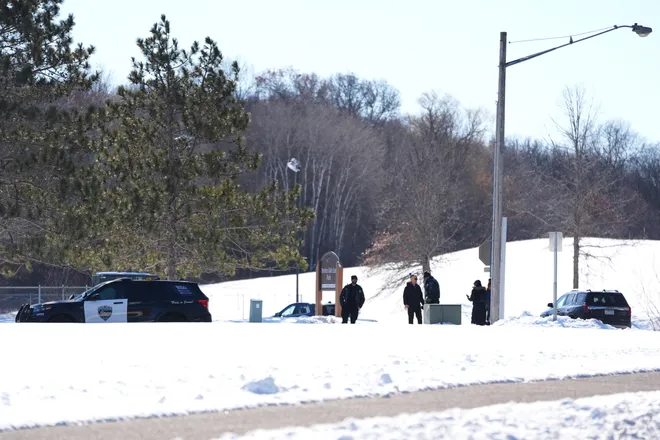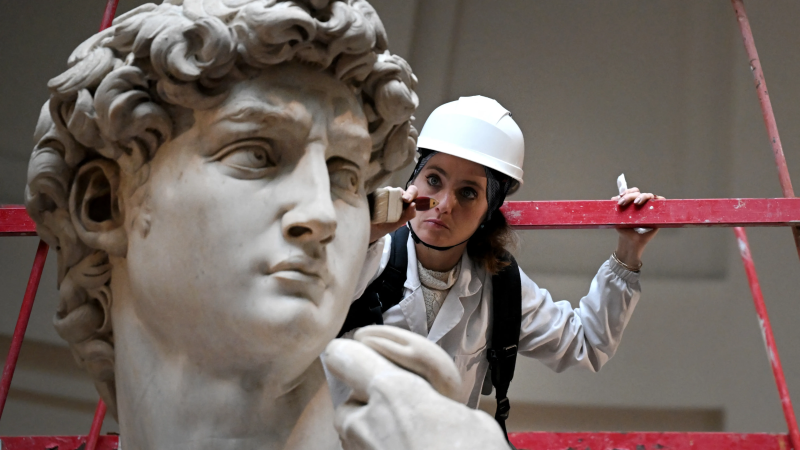Minnesota shooting highlights danger of domestic violence calls for first responders and victims
Two police officers and a firefighter were killed in Minnesota while responding to a domestic dispute involving a suspect previously convicted of assault and accused of domestic violence, a type of call experts say can be among the most dangerous for both first responders and those they're trying to help.
Police responded early Sunday to a call involving a heavily armed suspect barricaded inside a home with his family, including seven children. After hours of negotiating, the suspect opened fire, killing officers Paul Elmstrand and Matthew Ruge and firefighter Adam Finseth and injuring another officer, Sgt. Adam Medlicott.
The suspect, who died of a self-inflicted gunshot wound, was identified Monday as Shannon Cortez Gooden, a 38-year-old who was barred for life from owning firearms after a 2008 assault conviction and was previously accused of domestic violence by several women.
While each case is unique, domestic violence and law enforcement experts said several factors, including the presence of firearms and a history of violence, can make these situations more deadly for all involved.
"At a time when there's high emotions, some hopelessness involved, the outcome is always going to be unpredictable," said National President of the Fraternal Order of Police Patrick Yoes. "So for an officer, it is one of the most dangerous calls that we go to."

What makes domestic violence calls dangerous for first responders?
Mark Wynn, a domestic and sexual violence prevention trainer and consultant, said an arrest can be the most dangerous moment for everybody involved in a domestic violence situation.
“When the victim is trying to get out, it really boils down to the offender losing control and when they lose control, that's when they use more violence,” said Wynn, a retired Nashville Metropolitan Police Department lieutenant. “And that's when officers are at higher risk.”
Seven of the 47 law enforcement officers killed by firearms in the line of duty in 2023 died while responding to a domestic disturbance, according to a report from the National Law Enforcement Officers Memorial Fund. One study of FBI statistics indicates an average of 4,194 assaults on police officers occur each year during such calls, according to a 2017 research brief from Dolan Consulting Group.
"If the batterer was unemployed, had damaged property in the incident, shared a residence with the DV victim, was drunk, and displayed a hostile demeanor toward the officers when they arrived, there was a 1 in 4 chance that the DV batterer would assault the officers," the brief said, citing a 2011 study of more than 3,000 domestic violence calls handled by the Minneapolis, Milwaukee and Miami-Dade police departments. "The more of these characteristics that were present at the call, the more likely an officer assault was to occur."
Domestic violence calls can become dangerous for officers because they are often emotionally charged situations in which police may not know much about a suspect’s history, according to Troy Anderson, executive director of officer safety and wellness for National Law Enforcement Officer Memorial Fund.
“If you know that there's a substance abuse issue, there's been prior, let's say, domestic violence cases or prior resisting arrest cases, and there's firearms involved, I mean, this is a recipe for disaster,” he said.
Anderson said one of the most crucial parts of preparing officers to respond to domestic violence calls is making sure they have proper equipment like ballistic vests, helmets and shields. Law enforcement agencies also need to examine their policies and training to ensure officers think tactically when approaching these kinds of calls and prepare for a potential ambush, he added.
“Those types of calls, they are a very difficult call. I'm not going to tell you that they're not,” he said. “But there are proactive steps that every officer can take and every agency can take an order to try to best prepare their officers psychologically, emotionally, spiritually and equipment-wise as well.”
Study:Fewer police officers died in the line of duty in 2023, but a 'scary number' were shot
Domestic violence calls can be dangerous for victims, too
Calls related to domestic violence can be dangerous for first responders, but the danger to the victim and their family can be even greater, according to Joe Shannon, a spokesperson for Violence Free Minnesota, a statewide coalition of programs working to end domestic violence. Shannon said people of color in particular may fear being criminalized by the police, and distrust in law enforcement can prevent them from calling the police in the first place.
A 2021 survey by the National Domestic Violence Hotline found a quarter of respondents who had called police to report intimate partner violence or sexual assault said they'd been threatened with arrest and 55% said they were discriminated against.
And in December, Niani Finlayson, a 27-year-old Black woman, called police to report an alleged domestic violence incident and was shot by a deputy less than a minute after she opened the door holding what deputies identified as a knife, according to body camera footage released by the Los Angeles County Sheriff’s Department.
Some of the factors that make domestic violence calls dangerous for first responders can also increase the risk of homicide within a relationship, including access to firearms and a history of violence against the victim, Shannon said, citing a recent 30-year retrospective from his organization on intimate partner violence in Minnesota. He said attempts to leave the relationship and the perpetrator threatening to kill the victim also greatly increased the risk of homicide, according to the report.
Of the nearly 23,000 victims of murder and nonnegligent manslaughter killed in 2021, 34% of women and 6% of men were killed by an intimate partner, according to the Bureau of Justice Statistics. And according to the Centers for Disease Control and Prevention, about a third of women and a quarter of men report having experienced severe physical violence from an intimate partner during their lifetime.
Ultimately, Shannon said incidents like the Burnsville shooting highlight the need to provide people experiencing domestic violence more resources and alternatives to calling the police.
“When people who are supposed to de-escalate a situation show up in military gear and with their guns drawn, that's not de-escalating a situation, and so it increases risk,” he said.
Better training, laws could improve safety in domestic violence cases

Wynn, the former Nashville police lieutenant, said the nation needs better laws restricting offenders' access to guns, noting many in law enforcement are “really, really concerned” about the outcome of a closely watched case before the Supreme Court involving a law banning domestic abusers from owning guns.
He added officers also need more training on how to respond to domestic violence incidents and more specialized teams to review cases that have a potential to lead to homicide and prevent the violence from escalating.
“In my mind, it's always been about keeping these victims alive,” Wynn said. “If we do a good job at that, then we often make our officers much more safe.”
If you are a victim of domestic violence, the National Domestic Violence Hotline at 800-799-7233 allows you to speak confidentially with trained advocates online or by the phone, which they recommend for those who think their online activity is being monitored by their abuser. They can help survivors develop a plan to achieve safety for themselves and their children.
Contributing: The Associated Press; Christopher Cann and John Fritze, USA TODAY
Disclaimer: The copyright of this article belongs to the original author. Reposting this article is solely for the purpose of information dissemination and does not constitute any investment advice. If there is any infringement, please contact us immediately. We will make corrections or deletions as necessary. Thank you.






